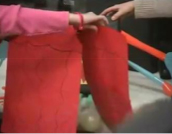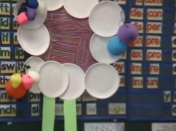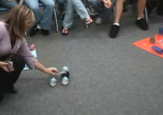This has been a Halloween themed week of videoconferences. It was our first busy week since October state testing ended. Here are the programs we enjoyed:
Monster Match

 We had 21 classes participate in Monster Match with Region 12, and 1 class do Monster Exchange with Dallas ISD. Be sure to read more about how Region 12 runs Monster Match here, here, and here. There are other methods of doing this project – see Dallas ISD and Humble ISD‘s pages. I noticed a lot of Monster Match copycat projects in CAPspace too.
We had 21 classes participate in Monster Match with Region 12, and 1 class do Monster Exchange with Dallas ISD. Be sure to read more about how Region 12 runs Monster Match here, here, and here. There are other methods of doing this project – see Dallas ISD and Humble ISD‘s pages. I noticed a lot of Monster Match copycat projects in CAPspace too.
Scary Art
We have an 8th/9th grade art teacher that annually participates in Scary Art with Arielle at The Cleveland Museum of Art. Paintings not for the faint of heart! The class that participated this year was a drawing/painting class and the program fit well with their studies.
Dia de los Muertos
A 6th grade Spanish class (teacher was a Jazz 09 grad) had 3 classes participate in the new Dia de los Muertos program with the Cleveland Museum of Art. It’s a “special request” program not even on their listing. The presentation could have been in all Spanish, but ours students weren’t ready for that. So we had partial Spanish, mostly English. The program includes an art project making a skeleton. Students really enjoyed it and learned all about the celebration.
Boo! I’m a Bat!
A preschool class connected to the Cleveland Zoo for their Boo I’m a Bat presentation, led by an educator in a witch costume. Students learned all about bats.
Day of the Dead
Tommy Bearden invited my schools to participate with his national audiences for a Day of the Dead all day celebration. I wasn’t able to get anyone to sign up soon enough to actually present, but I have 5 high schools connected all day with Spanish classes rotating in and out watching throughout the day.
 Halloween Slime Time
Halloween Slime Time
Finally, I have a first grade class that every year participates in Halloween Slime Time on the states of matter with the Ann Arbor Hands-On Museum. This is a great program with hands-on experiments for each pair of students. Highly interactive and visually appealing!
Next…
Next week we move into our ASK programs with ASK Specialist: Stellaluna, interviewing bat experts at Cranbrook.
So have you done any of these VCs or similar ones? Please share and comment on your experience/recommendations…





















 This morning I took a trip up to Van Buren ISD (which just was awarded a RUS grant – congrats!!). They are hosting the
This morning I took a trip up to Van Buren ISD (which just was awarded a RUS grant – congrats!!). They are hosting the 





